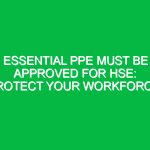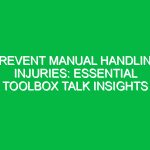Introduction
In the realm of health, safety, and Environment (HSE), PPE, or Personal Protective Equipment, plays a pivotal role in safeguarding individuals from various workplace Hazards. The PPE Personal Protective Equipment definition encapsulates not only the physical items used but also the broader implications of ensuring Safety and well-being in various environments—from construction sites to healthcare facilities. Understanding this definition is crucial for organizations striving to comply with Safety Regulations and protect their workforce.
As workplaces evolve, so do the complexities associated with health and safety management. In this article, we will explore the PPE personal protective equipment definition, its significant components, the regulatory landscape surrounding it, and real-world implications. By delving into these aspects, we aim to equip readers with a comprehensive understanding of PPE in the context of HSE.
Decoding PPE: The Personal Protective Equipment Definition
The PPE personal protective equipment definition refers to all equipment worn to minimize exposure to Hazards that cause serious workplace injuries and illnesses. This equipment can include a variety of items such as gloves, safety glasses, helmets, and respiratory protection, among others. The primary goal of PPE is to create a barrier between the worker and the potential hazards they may encounter.
PPE is categorized into several types based on the risks they address:
- Head Protection: Helmets and hard hats designed to prevent head injuries from falling objects.
- Eye and Face Protection: Safety Goggles and face shields that guard against chemical splashes and flying debris.
- Hearing Protection: Earplugs and earmuffs that reduce noise exposure in loud environments.
- Respiratory Protection: Masks and respirators that filter harmful airborne particles and gases.
- Hand Protection: Gloves that protect against cuts, chemicals, and thermal hazards.
- Foot Protection: Steel-toed boots and safety shoes that shield feet from heavy objects and Electrical Hazards.
In essence, the PPE personal protective equipment definition serves as a foundation for understanding how various items work collectively to enhance Workplace Safety.
The Importance of PPE in HSE
The significance of PPE cannot be overstated. It acts as the last line of defense against workplace hazards, making it an essential element of any comprehensive health and safety program. A well-implemented PPE program not only protects workers but also contributes to the overall efficiency of an organization. For instance, in an industrial setting, the absence of proper PPE can lead to increased injury rates, resulting in lost productivity and higher insurance costs.
Consider the case of a manufacturing plant that faced numerous safety violations due to inadequate PPE usage. After conducting a thorough Training program and enforcing strict PPE protocols, the plant reported a significant drop in accidents—by over 30% in just one year. This example illustrates the tangible Benefits of understanding and implementing the PPE personal protective equipment definition effectively.
Key Components of Effective PPE Usage
The successful application of PPE hinges on several key factors:
- Assessment of Hazards: Organizations must conduct thorough risk assessments to identify potential hazards in the workplace. This assessment is critical for determining the appropriate Types of PPE required.
- Selection of PPE: Choosing the right PPE involves considering factors such as fit, comfort, and compatibility with other safety equipment. Ill-fitting PPE can compromise safety, leading to increased risk of injury.
- Training and Education: Workers must be trained on the correct use, maintenance, and limitations of PPE. This education ensures that employees understand how to use equipment effectively, fostering a culture of safety.
- Inspection and Maintenance: Regular inspections and maintenance of PPE ensure that equipment remains in good condition and is effective in protecting workers. Worn-out or damaged PPE should be replaced immediately.
Potential Hazards and Risks
Understanding the potential hazards that necessitate the use of PPE is crucial for any organization. Common risks in various industries include:
- Chemical Exposure: Workers in laboratories or manufacturing facilities may be exposed to hazardous chemicals, necessitating the use of gloves and respiratory protection.
- Physical Hazards: Construction sites often present risks from falling objects, requiring helmets and Eye Protection.
- Noise Exposure: Environments with high noise levels can lead to hearing loss, making hearing protection essential.
- Biological Hazards: Healthcare workers may encounter infectious materials, necessitating gloves, masks, and gowns.
Recognizing these hazards allows organizations to tailor their PPE programs to address specific risks effectively. This proactive approach not only protects employees but also enhances overall workplace morale.
Regulations and Standards Governing PPE
Compliance with regulations is a fundamental aspect of any health and safety program. Various organizations and government bodies establish standards for PPE usage to ensure worker safety. Some key regulations include:
- Occupational Safety and Health Administration (OSHA): In the United States, osha has set forth regulations mandating the provision and use of PPE in workplaces where hazards exist.
- ANSI Standards: The American National Standards Institute (ANSI) develops standards for PPE to ensure safety and effectiveness in various applications.
- European Union Directive: In Europe, the Personal Protective Equipment Regulation (EU) ensures that PPE complies with strict safety and health requirements.
Understanding these regulations is essential for organizations to maintain compliance and protect their employees. Non-compliance not only exposes workers to risks but can also result in hefty fines and legal repercussions.
Best Practices for PPE Implementation
To ensure a successful PPE program, organizations should adhere to several Best Practices:
- Engage Employees: Involve workers in the selection and evaluation of PPE. Their input can provide valuable insights into the practicality and effectiveness of equipment.
- Regular Training: Conduct training sessions regularly to keep employees informed about new hazards and PPE advancements.
- Encourage Reporting: Create a culture where employees feel comfortable reporting PPE deficiencies or hazards without fear of retaliation.
- Monitor Effectiveness: Regularly review and assess the effectiveness of your PPE program, making adjustments as necessary to address new risks.
Real-World Examples of PPE Success
Real-life scenarios highlight the importance and effectiveness of PPE in various industries. For instance, a construction company that implemented a rigorous PPE program saw a drastic reduction in incidents. After a safety audit revealed that many workers were not wearing their helmets consistently, management reinforced the importance of head protection through training and incentives. As a result, the company reported a 50% drop in head-related injuries over two years.
Similarly, in the healthcare sector, the COVID-19 pandemic underscored the critical importance of PPE. Hospitals that prioritized the use of appropriate PPE for staff experienced lower infection rates among healthcare workers. This example emphasizes how the PPE personal protective equipment definition extends beyond compliance—it is a matter of life and death in certain circumstances.
Conclusion
In conclusion, the PPE personal protective equipment definition is a vital component of health and safety in the workplace. By understanding its significance, organizations can better protect their employees from the myriad of hazards they face daily. Effective PPE programs not only comply with regulations but also foster a culture of safety, ultimately leading to enhanced productivity and morale.
As workplaces continue to evolve, so must our approach to PPE. Continuous education, assessment, and improvement are essential to ensure that personal protective equipment remains a robust defense against workplace hazards. By prioritizing safety and compliance, organizations can unlock the true potential of their workforce, paving the way for a healthier, safer, and more productive future.


